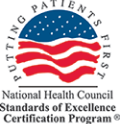Alpha-1 Antitrypsin Deficiency (Alpha-1) can be diagnosed with a simple blood test.

Who should be tested for Alpha-1?
The latest clinical guidelines recommend Alpha-1 testing for:
- People with COPD (chronic obstructive pulmonary disease), a group of lung diseases, including emphysema, that block airflow and make it difficult to breathe
- People with unexplained chronic liver disease
- People with panniculitis, a skin condition that some people with Alpha-1 develop
- Parents, siblings, children, and extended family members of people diagnosed with Alpha-1
Before Getting Tested for Alpha-1
Before getting tested for Alpha-1, it may help to speak with a nurse who can provide genetic counseling services for free by the Alpha-1 Foundation. A genetic counselor is a specially trained professional in genetics and genetic testing. They can explain the benefits and potential risks that may exist prior to testing.
The genetic counseling services program can help you understand the risks and benefits of testing for yourself and your loved ones.
Call 1-855-476-1227 to schedule a free appointment
Why should people be tested for Alpha-1?
Many people with Alpha-1 are unaware they have the condition. Because Alpha-1 causes the same symptoms as more common conditions like COPD and asthma, it can prove especially challenging to diagnose. In fact, it can take several years for many people with Alpha-1 to be correctly diagnosed with the condition. If you suspect you or a family member has Alpha-1, talk to your doctor about getting tested for Alpha-1.
Testing for Alpha-1 is the only way doctors can diagnose the condition. Diagnosing Alpha-1 early means getting treatment sooner, which may help slow or prevent lung damage.
Getting tested is also important so Alpha-1 carriers can determine if they can pass the Alpha-1-causing gene on to family members. An Alpha-1 carrier is a person who has one normal Alpha-1 gene and one abnormal Alpha-1 gene.
How can people get tested?
Alpha-1 can be diagnosed by a simple blood test. If the blood test shows lower than normal levels of AAT in the blood, the doctor might refer the person being tested for genetic counseling. Though Alpha-1 is diagnosed by a blood test, other tests may be performed to determine the severity of a person’s Alpha-1.
These tests may include:
- X-rays or CT scans of the lungs
- Pulmonary functioning tests (PFT)
- Liver ultrasound
- Liver biopsy (a small sample of tissue may be extracted)
Free Confidential Genetic Testing
The Alpha-1 Foundation provides free, confidential genetic testing through the Alpha-1 Coded Testing (ACT) Study, in partnership with the University of Florida. The test can be done at home with a simple fingerstick. Results are usually received within 4-6 weeks.
Please note you must use either a computer or a tablet to complete this online request for a kit. It will not work on a smartphone.
To learn more about the ACT Study, contact the University of Florida at 1-855-476-1227 or alpha1lab@alphaone.ufl.edu
Which family members should be tested for Alpha-1?
The Alpha-1 Foundation strongly encourages people with Alpha-1 symptoms and their family members to be tested. This includes:
- The parents of a person with Alpha-1
- The siblings of a person with Alpha-1
- The child/children of a person with Alpha-1
- Extended family members, such as aunts or uncles and cousins, of someone diagnosed with Alpha-1
Family members may have one or two Alpha-1 genes and not be aware of their own health risks and the chance of passing on the Alpha-1 gene to their children. If they learn they have Alpha-1 or are a carrier, they may consider making lifestyle, professional or personal choices that could maintain or improve their health.
Read the It’s All the in the Family brochure to learn more about testing for Alpha-1
Watch this video on family testing for Alpha-1











